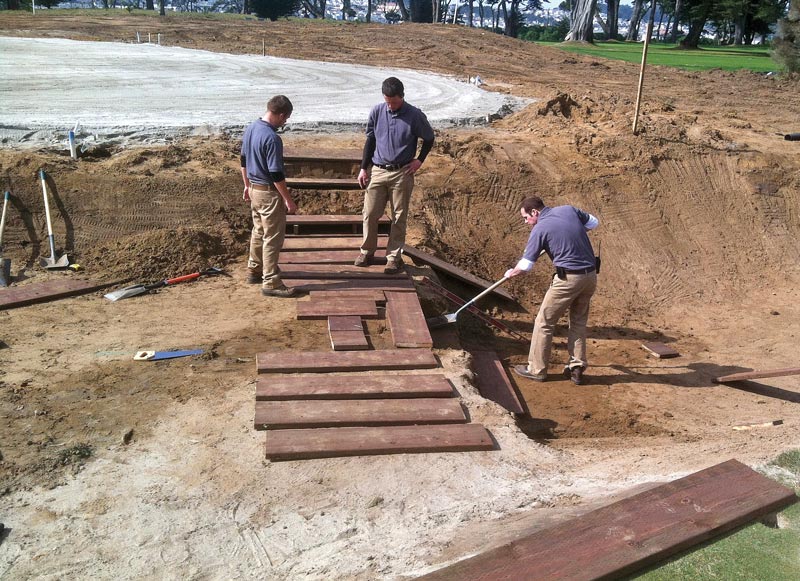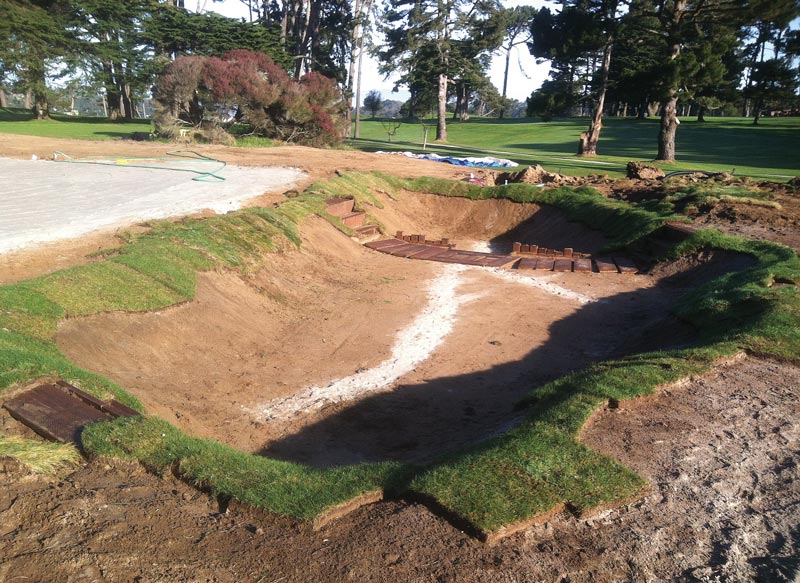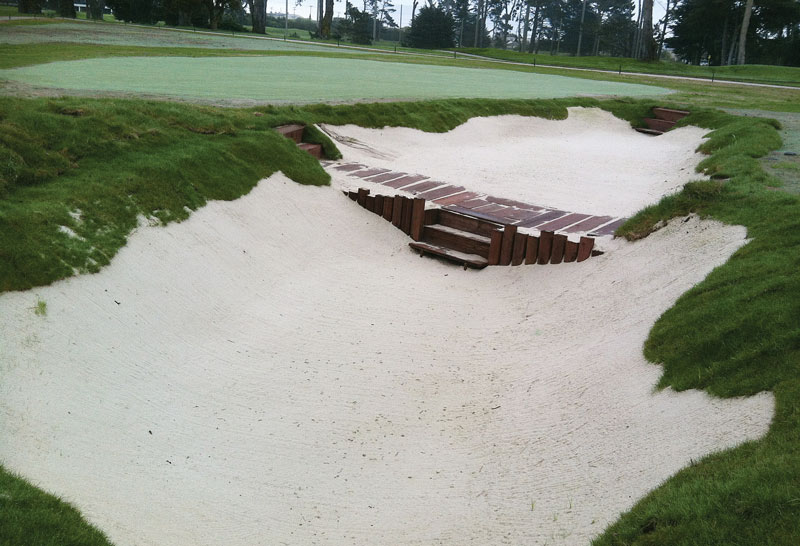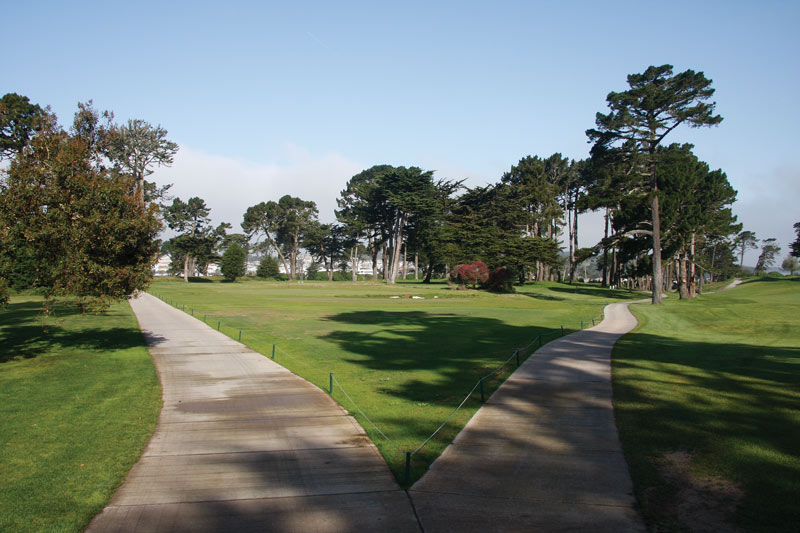
Lake Merced Golf Club’s new practice facility was built entirely with in-house labor and on a shoestring budget. Photos courtesy of Zachary Ohsann
The key to any practice facility is utility. Can the members use it? Will they use it? What does it cost to build? And how easy is it to maintain?
While these are simple questions, they sometimes require intricate and creative solutions. At Lake Merced Golf Club in Daly City, Calif., we are challenged to accommodate our active membership within a relatively compact footprint. Our golf course sits on approximately 135 acres, so, needless to say, space is at a premium.
Although we have a practice range just outside the pro shop door, an adjacent practice bunker and pitching green, and an ample practice putting green, we faced a problem. Because of the slope of our driving range, it was impossible for players to practice a 75- to 100-yard wedge shot and see the ball land. There just wasn’t enough flat ground to do that. This left us without a place where members could work on golf’s true “money shot” and be able to gauge distance on this key short-game component.
Moreover, our one practice bunker was so deep in most parts that our members couldn’t watch a sand shot land and roll out. People would hit practice shot after practice shot, but they would never know precisely how far they were hitting the ball or how it was rolling after it landed.
To compound the problem, our practice bunker and the surrounding pitching area were getting beaten up from excessive use.
A space emerges
We had an opportunity to change things after we moved our maintenance facility from the middle of the course to a location in the southwest corner. The construction of that facility (as well as our new clubhouse and recycled-water storage tank) was the subject of a previous article in the USGA Green Section Record (November/December 2005). As a result of the move, we freed up a nice little stretch of land in the middle of our property, and it was ripe for conversion into an additional practice area.
The process may have taken a few years, but we were able to come to a consensus about what we wanted and how to accomplish it. Working entirely in-house, we designed a practice area that also doubles as our turf nursery. We now have three nursery greens — 10,000 square feet of good ground on which to grow, test and analyze turf. The area is bordered by our 14th, 15th and 16th holes.
In the area between two of the nursery greens, we constructed a unique and very user-friendly practice bunker. The new bunker has two distinct levels. Approximately two-thirds of it is 3½ feet deep, simulating our course’s typical “shallow” bunker shot. In this portion of the bunker, a player can indeed see his or her shot fly, land and roll out. It’s a great spot to hone one’s sand game.
The remainder of the bunker is what we call the “basement.” It’s almost 6 feet deep and replicates the deep bunker shot found on many of our holes. This section enables our members to take a few steps down and practice an escape they’ll need should they encounter one of our deeper bunkers.
Because the new practice bunker is between two of the nursery greens, players can hit shots in several directions. They can experience every type of wind and sun condition. The variety of different shots is endless.
The long and short — really, the up and down — of this story is that we have a single bunker that serves multiple purposes. Instead of two separate bunkers, our crew now needs to tend to only one and has fewer edges to maintain. Wood planking and steps make entry and exit easy for all. If a player hitting pitch shots over the sand wants “direct line” access to the green, he or she can simply walk right through the middle of the bunker without disturbing anything.
What really makes this area attractive — beyond the one-of-a-kind dual-level bunker — is the fact that players can hit a 100-yard shot as well as every other kind of short-game approach, right down to little running chips to one of our nursery greens. In the weeks to come, we expect to see our members inventing small short-game tournaments on and around our practice area. Hopefully, this forgotten part of the property will now become a great gathering spot in the early evenings for after-hours fun (and practice!).
Making it work
In constructing the bunker, we worked entirely with our own crew — no outside construction firm was involved. Whenever possible, we tweaked the design to accommodate future maintenance needs (such as including convenient entry points for mowers and other equipment).
The most difficult issue we encountered with this project was cost. We had to balance the need for a secondary practice area to alleviate heavy traffic on the existing area against the burden of spending money to create an added facility on our property. Needless to say, this challenge is one that superintendents (and boards of directors) face every day all across the country.
When responding to inquiries, it was essential for us to premise support on the agronomic benefits of the new turf nursery, and also to focus attention on an equally important aspect of the project: the added benefits of a new practice area for our club members.


Located between two nursery greens, the practice bunker at Lake Merced Golf Club was designed with an emphasis on ease of maintenance. Wood planking and steps dividing the upper and lower levels help prevent golfers from disturbing the sand.
The enhancement of the existing turf nursery — and the possible creation of this very compact, added practice area — had been a constant discussion topic at green committee meetings for nearly three years. The fact is, many members wanted more space to work on their wedge play, bunker shots and especially chipping from all angles.
With many veteran green committee members supporting such a project, it was essential for our golf maintenance staff to gain their insight concerning the layout of the area from a playability standpoint. We asked the green committee members (and anyone else who was interested) to meet with our staff at the old nursery area to discuss possible locations for additional nursery greens and some type of practice bunker.
The primary focus of the meeting was to determine how to maximize the playing surface of such a small area. Looming over everything was the question of cost. But the green committee members who participated were receptive to the cost implications that arose from many of the suggested designs (e.g., moving existing irrigation). As Lake Merced’s superintendent, I was able to work my way through the financial issues and come up with a plan that would satisfy everyone. We were determined as a group, working cohesively, to get the job done right for the right price.
Fortunately, our working group embraced the challenge of enhancing the area on a small budget and with few resources. We solicited member feedback throughout the project. Equally important, we rolled up our sleeves to get the job done. With the help of a working group representing a wide range of golf handicaps, the green committee and our staff reached a consensus by incorporating maintenance input into the final design.
Getting our hands dirty
After we had locked in a design concept, a thorough proposal was created for the purpose of formalizing the discussion and itemizing all the costs that would be associated with the project. One key element of our plan was to do the necessary work only when staff was available. We wanted to make this project a reality without having to sacrifice course conditions or other maintenance needs in any way.
To that end, the work was completed during the crew’s “downtime.” There was very little overtime or added labor expense involved. We were also able to rely on labor from two of our interns, Tim Crowley and Nick Dowe, who proved to be more than just a little resourceful.
The raw materials used (sand, gravel, drainage pipes, planking and seed) totaled less than $7,000. At the end of the day, we were able to achieve a finished, grown-in practice area for under $10,000.

Before the construction of the new practice facility at Lake Merced Golf Club, the slope of the driving range prevented golfers from seeing the practice bunker. The new facility, which is positioned in the middle of the course, features a new practice bunker with edges visible from a distance.
With the bulk of the project’s cost going to sand and gravel materials, we were under pressure to complete the project using only resources we already had on site, and Crowley and Dowe were front and center in those efforts. Instead of renting a trencher to install the drainage pipe, we used old-fashioned muscle. They were tasked with creating something out of nothing by reusing irrigation sprinklers, cutting drainage line lengths cautiously, and relying only on the equipment and implements at hand.
While the success of the practice area has largely been attributed to the blood, sweat and tears that Crowley, Dowe and our entire staff put into the project, it’s also important to acknowledge the efforts of our green committee and of one particularly energetic member of that committee who was intimately involved from the get-go. He was the one who actually designed the layout of the practice area, conceived the idea of a two-level bunker, prodded us to install planking, and even stepped up with shovel in hand to help shape the bunker itself. He spent untold hours with us tweaking details in the field, and took considerable time away from his day job — and his golf game — to focus on the project.
All of these sacrifices were worth it for all concerned. Indeed, building a useful, creative practice facility at this cost and knowing that it will last for a generation is one of the greatest bargains in the long history of our club.
Zachary Ohsann is the golf course superintendent at Lake Merced Golf Club in Daly City, Calif., and a nine-year member of GCSAA.